Read MCN's ultimate guide to choosing motorcycle tires before you get your next pair
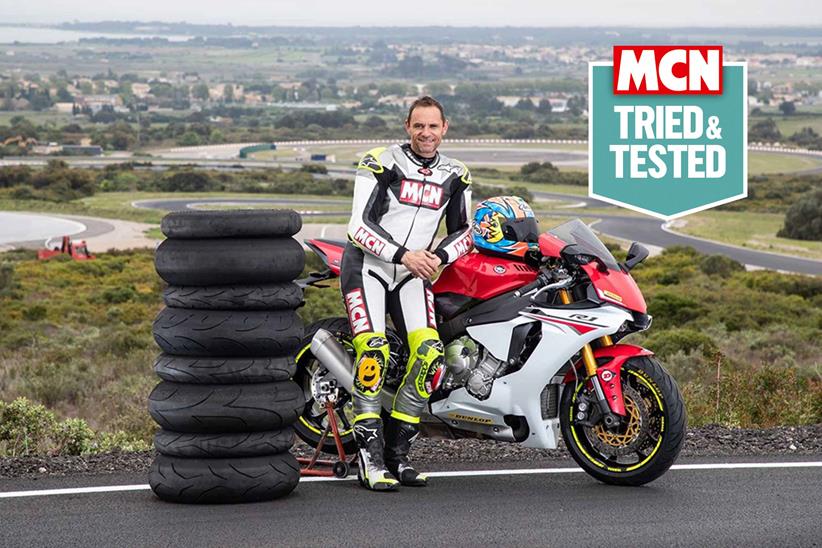
Besides the obvious things tires do, they’re also the primary channel of communication between you and your motorcycle. They can inspire confidence, or leave you guessing what’s going on. It’s the most critical piece of equipment on your bike. It makes sense that choosing tires is tough. There’s countless opinions, both anecdotal and (occasionally) fact-based. And finding a good deal on tires takes work and comparison.
But a short list of criteria makes things easier. Your riding experience, the kind of bike you have, and the riding you do will all determine your best choice. A Ducati Panigale V4R rider looking for the best track day tire has different needs than someone looking for sport touring tires to fit their Suzuki GSX-S1000GT+.
The choice of tire depends on the bike. A hard-wearing touring tire works well on a sub-100hp middleweight struggle. But if fitted to a 200hp superbike, not so much. Even different engine layouts and firing orders affect tire performance and grip. Bike weight, braking power, and suspension also play a big role.
Cut through the jargon with MCN’s tire explainer video:
Best Motorcycle Tires at a Glance
- Best for Sport Tourers Metzeler Roadtec SE 01
- Best for Off-Roading Continental TKC 80 Twinduro
- Best Dual-sport or Adventure-sport Tires Dunlop Trailmax Raid
- Best Sport Road Tire Pirelli Diablo Rosso IV Corsa
- Best Track Day Tire Metzeler Racetec RR
Here, we’ve picked tires that perform well across a range of motorcycles. For a more in-depth look, check out our motorcycle tire category guides. Or explore our in-depth tire FAQ. And if you want to save money, consider changing your own tires here.
Best Motorcycle Tires
Best for sports-tourers
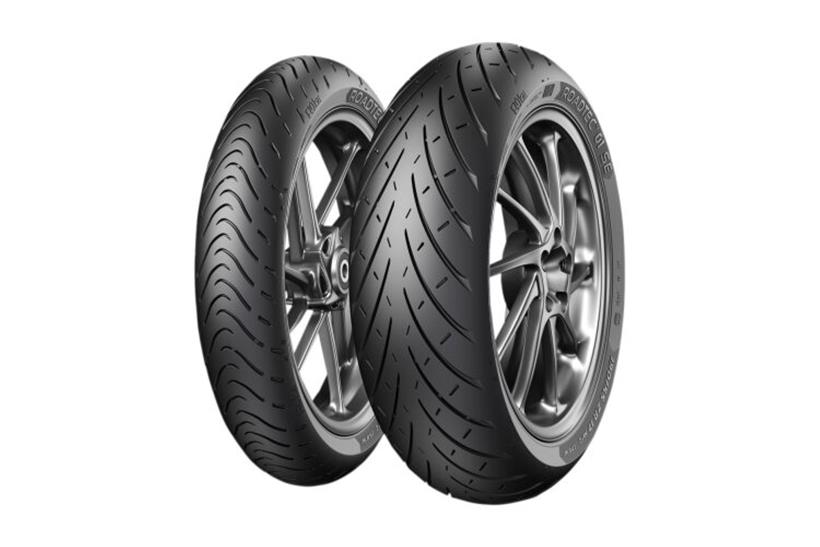

Still the go-to sports touring tire, the SE 01 steers more like sports rubber, bites hard in the dry, and has incredible levels of wet grip under severe braking and acceleration. They've proven to be a great performer in all on-road scenarios, from dry roads to a wet race track, and offer great confidence and sharp steering.
For all-weather, big mileage riders, you can expect around 6-8,000 miles from a rear, or more. And despite its sportier pretensions, the new Roadtec 01 SE still lets you walk on water whether you ride a naked, sports tourer, or even a sportsbike.
They feature a dual compound rear, and warm up quick enough that you won't have any problems going about your business when a national speed limit sign beckons.
If you're looking for a tire to look after you in all conditions, the new Metzeler Roadtec 01 SE take the crown from their predecessor as being the go-to sports touring tires.
Read our full Metzeler Roadtec SE 01 review.
Pros
- Grip from cold
- Incredible wet weather performance
Cons
- Slightly unsettled by bumpy, fast corners
Best for off-roading
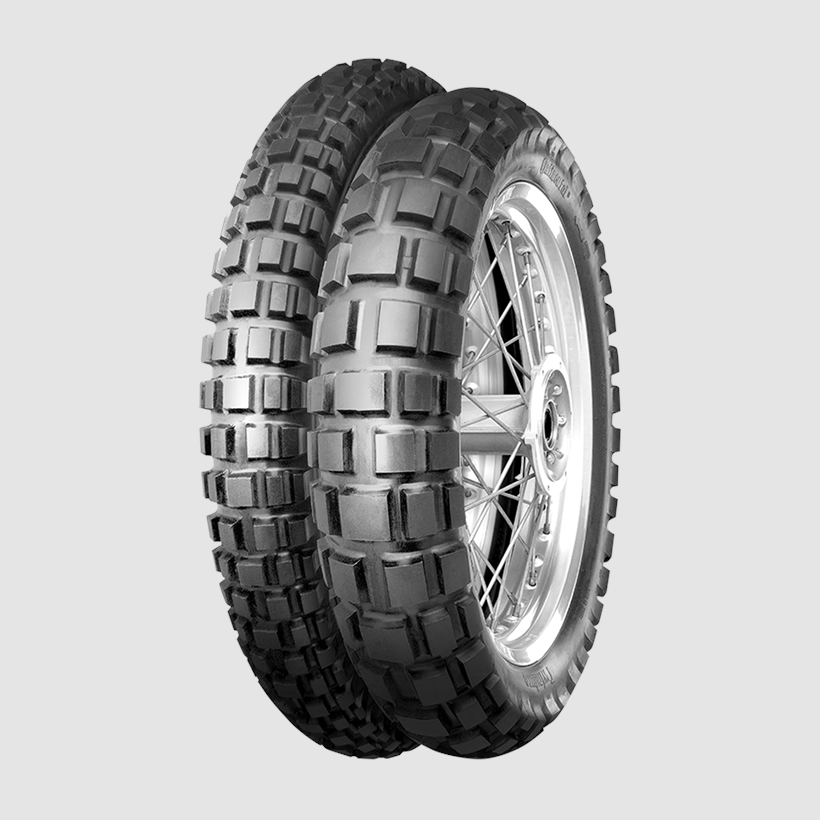

Unless you spend a significant chunk of your riding life exploring greenlanes, the TKC 80s will feel too compromised. They are noisy on the tarmac and prone to a gentle weave at high speed. But if you want something with more ability on the black stuff, then read on.
The continental TKC 80 Twinduro is described by the manufacturer as the 'King of the dual-sport market'. Its large tread blocks give excellent traction in wet and muddy conditions, which make them great for trails and greenlaning. The large spacing is referred to as a 'self-cleaning' tread pattern, which means it will clear mud and gravel away from the tread-block edges, allowing them to steer and drive the bike forward across rough terrain more effectively.
They're claimed to offer remarkable durability too, which makes them a good choice for extensive adventure riding.
Overall the Continental TKC 80 Twinduro tires make a great off-road tire that can still take some pavement if needed.
Pros
- Great off-road ability
- Big blocks for mud
Cons
- Noisy and vague on the road
Best dual-sport or adventure-sport tires


On road, the grip is impressive, and they have a high level of support when braking and under load - qualities that Dunlop are famous for. But despite that signature carcass strength, there's still an impressive amount of feel, and they feel very confidence inspiring to ride. Michael Guy found it hard to put them through anything they can't handle.
Off road, they feel stable and predictable, even on loose, dry sandy gravel. They perform about on-par with some of the more aggressive off-road adventure tires, such as the Michelin Anakee Wild, or Continental TKC80.
Overall, the Dunlop Trailmax Raid make for a great set of dual-sport or adventure tires. They perform on par with other adventure tires off-road, but with much better road performance than you'd expect.
Read our full Dunlop Trailmax Raid review.
Pros
- Excellent on and off-road performance
- Great wet weather performance
Cons
- Still a dual-sport tire
Best sporty road tire
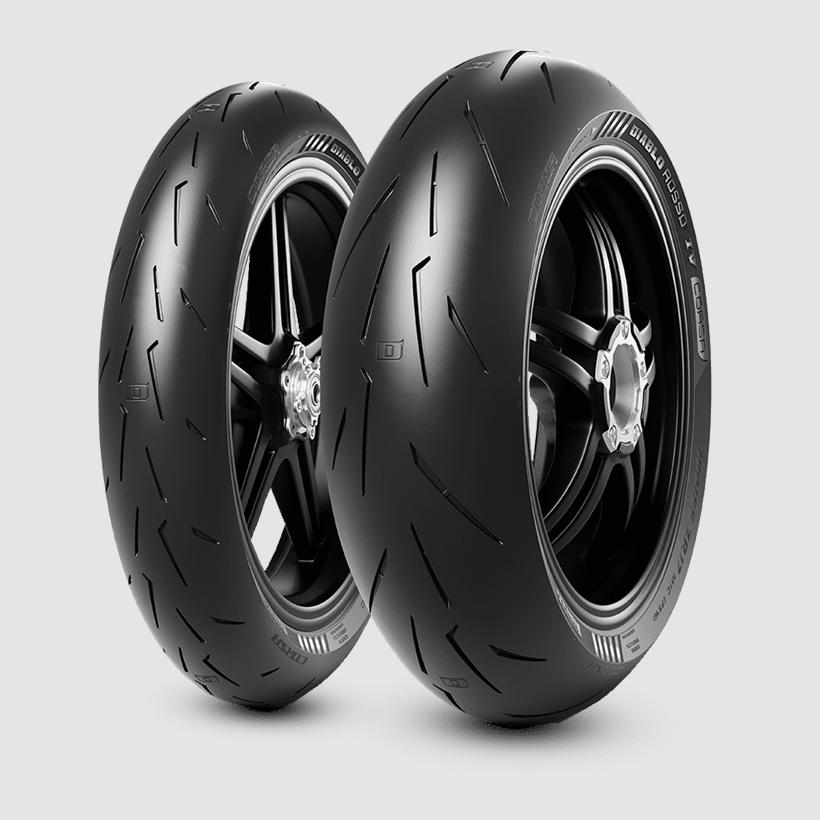

They're superb for rapid road riding or on track, only slightly firmer and slower steering than the Supercorsa SP's. They never leave you wanting more on the road, with good stability, and a lot of grip in the wet for such a sporty tire. If you ride a sports bike, superbike or sporty naked and you like to let your hair down, these are perfect.
They feature wide slick areas on the shoulders to bolster cornering support at extreme lean angles, and they are confidence inspiring to ride hard through corners. This includes a dual-compound construction, that enhances grip in the corners while retaining stability and durability.
Pirelli's patented 'Flash Groove' tread pattern is also claimed to give consistent performance over multiple 'severe' riding sessions, which should offer good durability without much loss of performance compared to their higher-end, or track-day tires.
Read our full Pirelli Diablo Rosso IV Corsa review.
Pros
- Great performance in wet and dry
- Fast warm-up time
Cons
- Still quite sporty
Best for trackdays


You get to choose from three compounds for both front and rear tires, depending on what you want to get out of your track day. K1 is a soft compound, that performs best when up to temperature, and offers its best performance on on smooth asphalt. Metzeler say the K1 excels at predictability and edge grip.
K2 is a medium compound, that will perform well at colder temperatures, and offers higher stability and precision when entering a corner. It's the most popular choice for track day riders, for its blend of grip and durability. K2 offers its best performance on abrasive asphalt surfaces.
Finally, K3 offers extra durability over the other two, at the cost of some performance. That makes it ideal for riders who do most of their riding on the road, but will thrash around on the odd track day too.
Pros
- Excellent performance
- Road legal
Cons
- Don't last long
How do I Check my Motorcycle Tire Pressure?
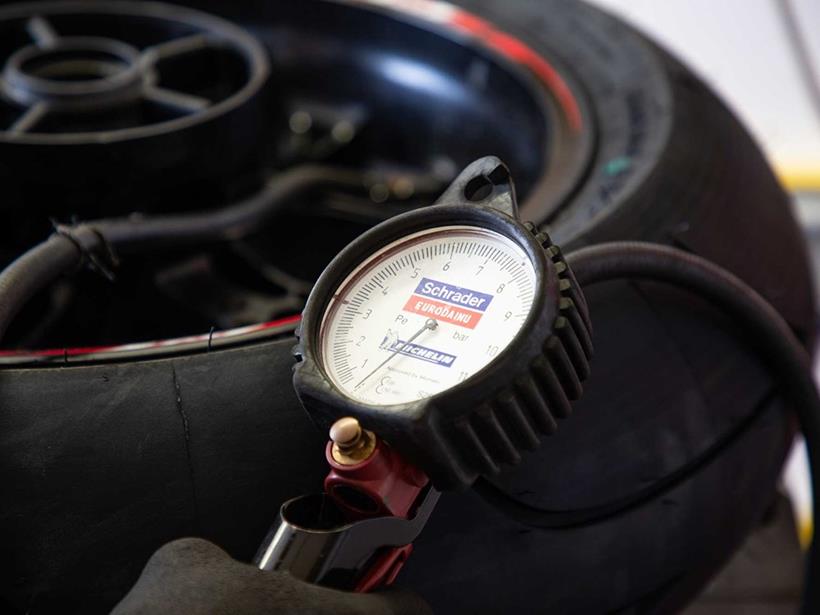
Checking tire pressures on a weekly basis is a good habit. It ensures crisp handling and helps you spot other things like a chain or brakes that need attention.
Motorcycle tire pressure tips
- Tire pressure should be checked when tires are cold. Tires are considered cold three hours after use after less than a mile of use.
- Gas station gauges are ok but inaccurate. There’s no substitute for a digital or pencil type.
- If a tire seems loses 5-10% a week, check for leaks from the valve itself. Use spit on your finger and draw it across the valve. If it bubbles up, you have a leaky valve stem.
- Don’t forget to replace the valve cap.
Finding the Perfect Track Day Tire Pressure
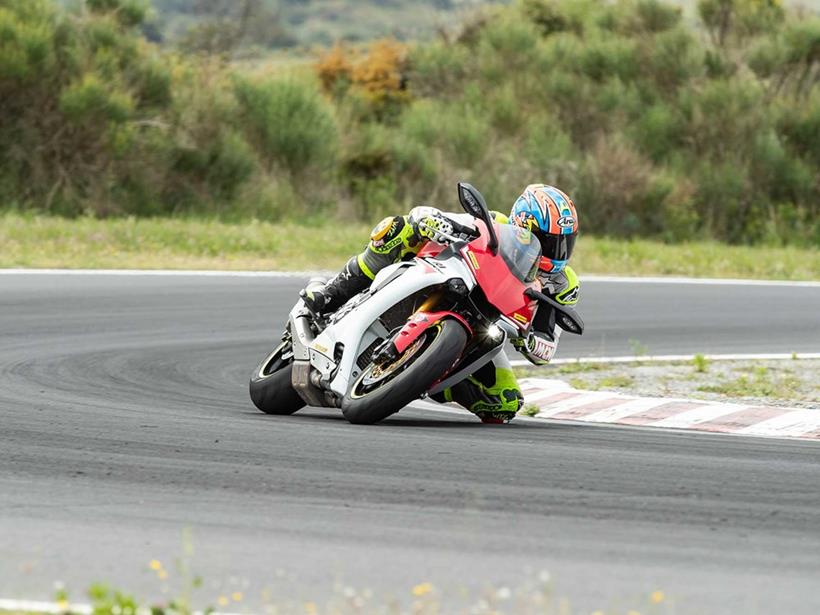
Track day are a great opportunity to test tire pressures. Remember, check pressure when the tires are cool. If you ride to track day, make sure tires have time to cool before checking. To be absolutely sure, a 3-4 hour wait might be needed for maximum accuracy.
While we recommend 36 psi front and 42 psi rear for road use, we drop four psi front and rear before attacking the track.
Don’t forget to go return to road pressures at the end of the day, especially if you’re riding home from the trackday.
Motorcycle Tire Sizes Explained

What on earth does “120/70 ZR17 M/C (58W) mean? It’s easy, trust us. Here’s what the numbers mean:
The first part is the tire width in millimeters — 120mm wide. Next is the aspect ratio, 70% of 120mm (height as a percentage of width). Though not part of the sizing/name, this tire is 84mm tall.
ZR refers to the speed rating and construction type. “Z” means the tire is capable of being ridden above 149mph, while “R” means it’s a radial tire, as opposed to bias-ply.
17 refers to the diameter of your wheel in inches. M/C denotes a motorcycle tire.
58W is the speed rating and load index respectively. “W” means it’s rated for a maximum speed of 168 mph at its correct pressure under load, while “58,” means the tire can carry up to 520 lbs. This seemingly contradicts the earlier “Z” designation of the tire being “capable of being ridden above 149 mph”, but it’s a legacy designation (connected to the “R”, meaning radial tire) and is usually left in place to preserve product designations. The “W” is a more current speed rating.
Head here to read the table showing the speed ratings and load index.
How to Pick the Best Motorcycle Tires for You
The number of choices seem bewildering. It takes a lot of riding to determine which tires perform better. Many riders stick to the tires they know or recommendations from friends. But it’s worth doing some research.
There are three types of tires for the road: sports, sports touring and fast road/track. Then there’s two for the circuit: trackday and racing.
Chances are, you’re replacing tires you’re already familiar with. Start with the size of your former tires as a baseline. Let’s use the example from the last section: 120/70 ZR17 M/C (58W)
You can go wider or narrower than 120, but likely not by much. Clearance issues with the frame and body work mean you don’t have carte blanche to use any tire you want. But a 130 tire might be possible. But it might just add weight and mass, while not handling as well.
More importantly, you can change the aspect ratio, or the “70” part. The bigger the number, the taller the tire. And the more sidewall radius you can use. A smaller aspect ratio will give you a “shorter” tire, meaning the curvature of the tire from sidewall to sidewall is flatter. This means less lean angle is available. This is fine with custom or chopper bikes, where lean angles aren’t important. But you may feel different. Again, pay attention to clearance in regards to body work, forks and swingarm.
The “ZR17” isn’t much to worry about. The high speed rating “Z” is better than a lower one. And if you have spoked wheels, you need bias-ply tires without the “R”, occasionally with a “-” designation instead. And unless you’re changing rim size, you’re sticking with 17” tires.
Lastly, the (58W) designation. If you’ll be adding weight with bags, luggage or a passenger, consider something rated higher than 58. And if you’re planning on track days, a high speed rating is key. “W” is already rated for 168 mph at appropriate loads, but if you’ve got “V” and you’ve got high-speed plans, consider your options. But as mentioned earlier, sticking with the dimensions from your old tires is advisable.
The real variable comes from tread patterns, tire type and manufacturer. These will make the biggest difference in performance. Some people swear by Pirelli’s, other love their Bridgestones, Avons or Dunlops. It mostly comes down to trial, error and trusted sources. It also helps to borrow comparable friends’ bikes to compare tire performance.
To find out we’ve gathered all five genres of 17″ rubber from a single manufacturer: Dunlop and we’ll put them through a number of scientific tests at their Mireval facility in the south of France. These tire categories are indicative of what’s available from Dunlop and most other leading manufacturers.
Scrubbing in Motorcycle Tires

Do people still scrub in new tires? Yes, despite modern technology.
Jim Worland, Metzeler UK Director, told MCN: “There’s a big misconception that tire molds have a release agent and that needs to be worn off before the tire will start to grip. That’s not the case with our tires, the molds are highly polished and the tire comes out easily.
“When you start riding on a new tire, it’s not just the contact patch that needs bedding in, it’s the whole structure. There are a lot of components including the steel belt, aramid fibers, nylon, rayon, silica, carbon black, oils and a complex mix of elastomers.
“Then there is how the tire is fitted on the rim, ensuring the beads are properly seated. It’s a running-in process similar to a new bike and it’s important to get the structure working in harmony with the wheel and giving the rider confidence-inspiring feedback.
“One thing that can affect your tire’s initial performance is how it’s been stored at the dealer or warehouse, as extended exposure to UV light can affect the compound performance.”
How to Check Motorcycle Tire Tread Depth

Assuming you’ve inflated tires properly, the tread pattern should have a depth of at least 1 mm (3/64 inch) throughout three-quarters of the breadth of the tread and round the entire outer circumference of the tire.
Many tires do not have grooves extending beyond the three-quarters breadth of the tread. So any and all grooves of the original pattern must have a minimum depth of at least 1 mm. That’s the absolute minimum. We opt to change our tires when tread depth reaches 2mm (5/64 inch), since the tire profile will be much degraded.
Pro tip: Buy yourself a tread depth gauge at your local car accessories shop.
How to Check Motorcycle Tire Condition
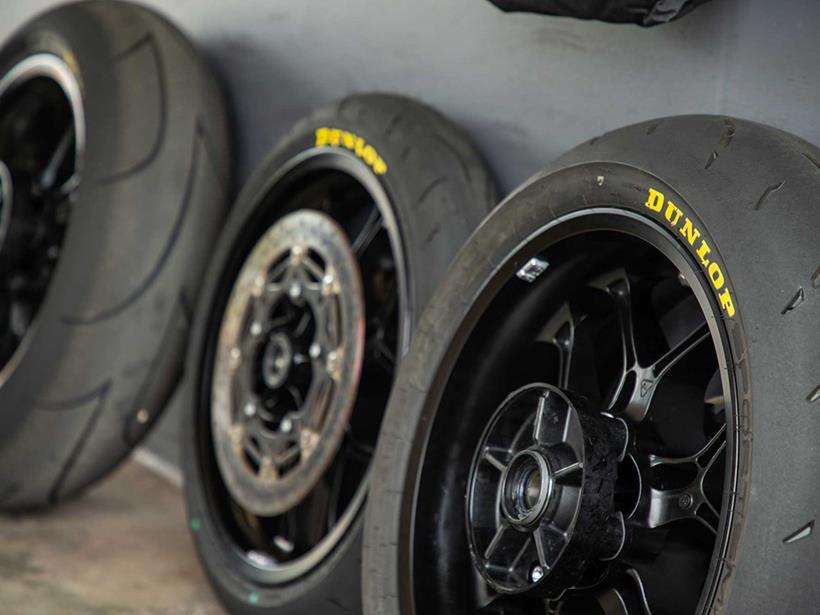
Regular inspection is important, as cuts may be deeper than you think. Nails and road debris can also get embedded without deflating your tire, so check periodically.
Carrying passengers or luggage can also lead to tire damage. Your owner’s manual will have correct tire pressures for your load. Otherwise, a good tip is to add 3 psi to both tires until you can verify the right amount.
Buying a secondhand bike usually means worrying about the condition of the engine. But tires are just as important. Check them carefully, especially with older bikes that may have original tires. Sunlight and fuel or oil exposure can degrade rubber over time.
It’s also easy to check how old a tire is. All tires will have a 4-digit date code on the sidewall with the week and year the tire was made. For instance, “1317” indicates the 13th week of the year (April), with 17 indicating 2017.
A punctured tire can be temporarily repaired if the puncture isn’t too big. A good rule of thumb (pun intended) allows punctures smaller than fingernail size to be patched. The damage must be on the tread only – never on the sidewalls. Any repair must be treated as temporary until you can replace it, ASAP. Take care to reduce speed when riding, as heat can weaken the repair. Repairs shouldn’t be made to tires with speed ratings of Z and above. For reference, that’s a tire rated for 149mph, common on many 600cc and higher bikes. Larger holes shouldn’t be repaired as the inner carcass is more likely to have been damaged.
A leaky (Schrader) tire valve core can be fixed by tightening the core with a valve key. Replace the core or valve if it still leaks after tightening. Remember, hot air expands, meaning the core might only leak when the tire is hot.
It’s important to remember valve caps help retain air inside a tire, but not for the reasons you may think. Caps should have an O-ring inside them. The seal prevents dust from entering the valve core, causing it to potentially stick. Caps also help air from escaping too suddenly if the valve core works loose. In other words, a slower deflation will give you time to safely pull over. Any flashy, novelty caps that don’t have a rubber-sealing ring inside them should be thrown away.
Tires are made to exacting standards, but there is always a slight imbalance between new tires and rim. An unbalanced tire causes vibration and accelerates tire wear. Balancing by use of weights is best left to dynamic machine balancers as they can detect exactly which part of the rim needs added weight.
Motorcycle Tires for Passenger Riding
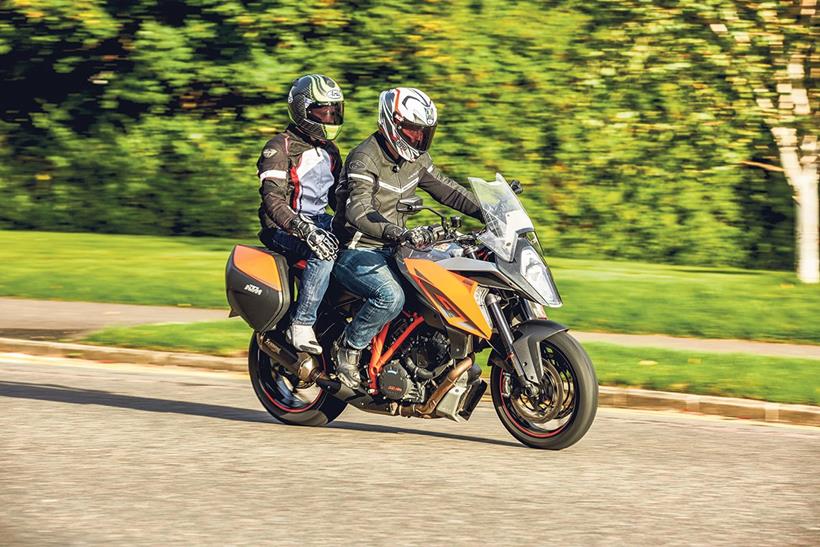
Many bikers don’t change tire pressures when carrying a passenger, but it’s a good idea. If you have it handy, refer to the owner’s manual for correct tire pressures for carrying passengers. If you don’t have the manual handy then it’s best to add 3 psi – 5 psi to account for the extra weight.
Motorcycle Tire Reviews by MCN
- Pirelli Angel GT II – ultimate all-rounders
- Dunlop SportSmart Mk3 – have your cake, and eat it
- Continental ContiTrailAttack 3 – impressive feedback and grip
- Bridgestone S22 – you won’t go far wrong fitting a set
- Just so you know, we may receive a commission or other compensation from the links on this website - read why you should trust us.


